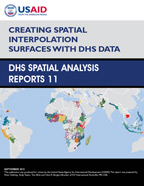- PUBLICATIONS
- JOURNAL ARTICLES
- ACCESS PUBLICATIONS
Publications Summary
- Document Type
- Spatial Analysis Reports
- Publication Topic(s)
- Geographic Information
- Language
- English
- Recommended Citation
- Gething, Peter, Andy Tatem, Tom Bird, and Clara R. Burgert-Brucker. 2015. Creating Spatial Interpolation Surfaces with DHS Data DHS Spatial Analysis Reports No. 11. Rockville, Maryland, USA: ICF International.
- Download Citation
- RIS format / Text format / Endnote format
- Publication Date
- September 2015
- Publication ID
- SAR11
Download
 Creating Spatial Interpolation Surfaces with DHS Data (PDF, 8705K)
Creating Spatial Interpolation Surfaces with DHS Data (PDF, 8705K)
